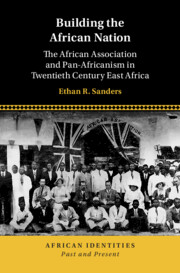
- Publisher:
- Cambridge University Press
- Online publication date:
- July 2025
- Print publication year:
- 2025
- Online ISBN:
- 9781009625616

How did people in East Africa come to see themselves as 'Africans,' and where did these concepts originate from? Utilizing a global intellectual history lens, Ethan Sanders traces how ideas stemming from global black intellectuals of the Atlantic, and others, shaped the imaginations of East Africans in the early twentieth century. This study centers on the African Association, a trans-territorial pan-Africanist organization that promoted global visions of African unity. No mere precursor to anti-colonial territorial nationalism, the organization eschewed territorial thinking and sought to build a continental African nation from the 1920s to the 1940s, at odds with later forms of nationalism in Africa. Sanders explores in depth the thought of James Aggrey, Paul Sindi Seme, and Julius Nyerere, three major twentieth-century pan-Africanists. This book rethinks definitions of pan-Africanism, demonstrating how expressions of both practical and redemptive pan-Africanism inspired those who joined the African Association and embraced an African identity.
‘Drawing on a wide range of institutional and private archives, including Julius Nyerere's library, Ethan Sanders offers a new way of thinking about eastern African political thought, moving us beyond the limitations of territorial nationalism. Building the African Nation fundamentally challenges our understanding of African intellectual history by showing how the African Association first imagined a united political community across eastern Africa.'
Jonathon L. Earle - Centre College
‘In this carefully researched book Ethan Sanders gives Pan-Africanism an altogether richer history. We usually think that national independence was the essential result of African political development; but here, in the history of the African Association, we glimpse the more capacious solidarities that early thinkers organized around. In a time such as ours, when resurgent nativisms cloud our vision and limit our charity, it is important to have a book such as this.'
Derek R. Peterson - University of Michigan
 Loading metrics...
Loading metrics...
* Views captured on Cambridge Core between #date#. This data will be updated every 24 hours.
Usage data cannot currently be displayed.
The PDF of this book is known to have missing or limited accessibility features. We may be reviewing its accessibility for future improvement, but final compliance is not yet assured and may be subject to legal exceptions. If you have any questions, please contact accessibility@cambridge.org.
Allows you to navigate directly to chapters, sections, or non‐text items through a linked table of contents, reducing the need for extensive scrolling.
Provides an interactive index, letting you go straight to where a term or subject appears in the text without manual searching.
You will encounter all content (including footnotes, captions, etc.) in a clear, sequential flow, making it easier to follow with assistive tools like screen readers.
You get concise descriptions (for images, charts, or media clips), ensuring you do not miss crucial information when visual or audio elements are not accessible.
You get more than just short alt text: you have comprehensive text equivalents, transcripts, captions, or audio descriptions for substantial non‐text content, which is especially helpful for complex visuals or multimedia.
You will still understand key ideas or prompts without relying solely on colour, which is especially helpful if you have colour vision deficiencies.
You benefit from high‐contrast text, which improves legibility if you have low vision or if you are reading in less‐than‐ideal lighting conditions.